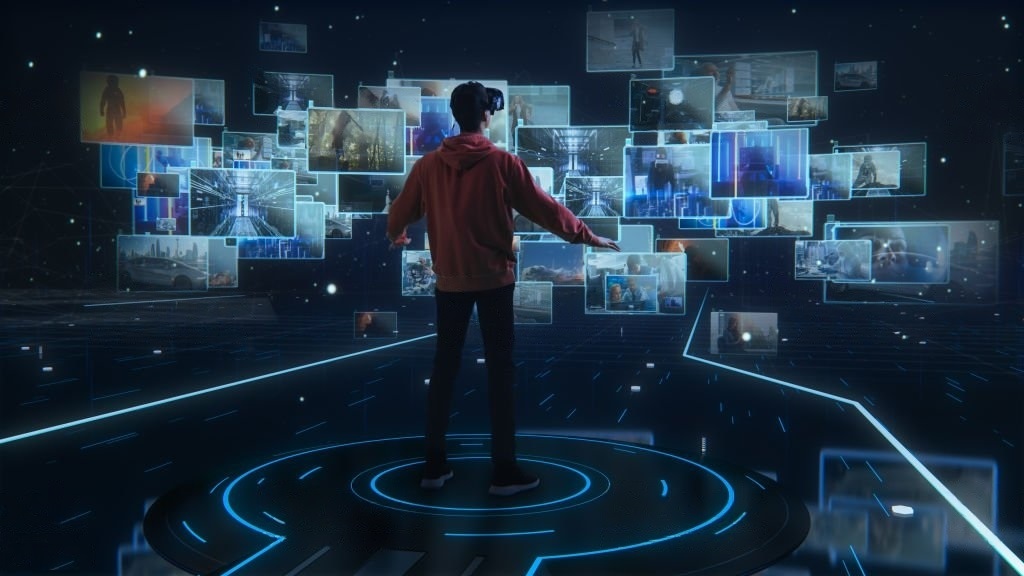Hey there! 😃
Have you ever wondered what it would be like if the digital world and the real world merged seamlessly?
Well, that’s exactly what Augmented Reality (AR) does! AR is a fascinating technology that’s been transforming the way we interact with our surroundings for years now.
So, what do you say?
Did you know that the concept of AR dates back to the 1960s? 😲
Yep, that’s right! It all started with a visionary computer scientist named Ivan Sutherland. He dreamt of a world where virtual objects could be displayed as if they were real, coexisting with our physical environment.
Stay with me, and together we’ll dive deep into the milestones, key technologies, and future prospects of this game-changing technology!
Let’s go! 🌟
Table of Contents
- Definition of Augmented Reality (AR) 🌐
- Brief overview of AR’s history and evolution 🕰️
- Importance of AR in today’s world 🌍
- Early Concepts and Foundations
- Milestones in the Development of AR
- Key Technologies behind AR
- The Evolution of AR Applications
- Future Prospects for AR
- Summary
So, you’re curious about Augmented Reality (AR)? You’ve come to the right place!
Let me explain everything in a way that’s super easy to understand, and I’ll throw in some cool examples, facts, and figures to make it even more interesting! 🎉
Definition of Augmented Reality (AR) 🌐
AR is a technology that combines digital elements, like images or videos, with the real world around you.
It’s like a layer of digital magic added to your physical surroundings!
For example, you know Snapchat filters, right? 😎 When you use a filter that adds a cute doggy face or a cool pair of sunglasses to your selfie, that’s AR in action! 🐶🕶️
Brief overview of AR’s history and evolution 🕰️
AR has been around for quite some time, with its roots going back to the 1960s when Ivan Sutherland imagined a world where virtual objects could be displayed as if they were real.
From there, we saw the development of VideoPlace in the ’70s, ARToolkit in the ’90s, and the first AR apps on smartphones in 2009. Remember Pokémon GO?
That game took the world by storm and was a perfect example of AR on mobile devices! 📱
Importance of AR in today’s world 🌍
AR is a big deal these days, and its impact can be seen across various industries.
In fact, the AR market is expected to reach a whopping $198 billion by 2025! 💰
That’s HUGE!
AR has the potential to revolutionize the way we learn, work, and even play. It’s being used in education, healthcare, retail, and many other sectors, making everyday tasks more engaging, efficient, and fun. 😃
Early Concepts and Foundations
First mentions of AR-like concepts in literature and science fiction 📚
Believe it or not, the idea of blending the digital and physical worlds can be traced back to some sci-fi books and movies!
One classic example is “The Sword of Damocles” by H. G. Wells, where he imagined a “magic shop” that could project holographic images.
How cool is that? 😮
And let’s not forget about “Star Trek’s” Holodeck, which inspired many to dream about immersive virtual environments. 🚀
Ivan Sutherland’s “Ultimate Display” (1965) 💡
Ivan Sutherland, a pioneer in computer graphics, came up with the concept of the “Ultimate Display” in 1965.
He envisioned a world where computers could generate virtual objects that would appear as real as physical ones.
This was a groundbreaking idea at the time and laid the foundation for what would later become AR. Talk about being a visionary! 🤩
Development of the first head-mounted display (1968) 🕶️
Ivan Sutherland didn’t just dream about the “Ultimate Display”; he actually went on to create the first head-mounted display (HMD) in 1968!
This HMD, called the “Sword of Damocles” (named after that H. G. Wells story!), was a massive contraption that hung from the ceiling.
Although it was bulky and not exactly user-friendly, it was a significant milestone in the development of AR technology. Can you imagine wearing something like that today? 😅
Milestones in the Development of AR
The creation of VideoPlace by Myron Krueger (1974) 🎥
In 1974, Myron Krueger, an artist and computer scientist, created “VideoPlace,” an interactive environment that allowed people to control digital objects using their body movements.
It was a groundbreaking project at the time and one of the earliest examples of AR-like technology. Pretty amazing, huh? 😮
Introduction of ARToolkit by Hirokazu Kato (1999) 🛠️
Fast forward to 1999, and Hirokazu Kato introduced the ARToolkit, a software library that enabled developers to create AR applications on desktop computers.
It was a game-changer, making AR more accessible to developers and paving the way for more widespread adoption of the technology. 💻
First AR applications on mobile devices (2009) 📱
In 2009, the world of AR took a massive leap forward with the introduction of AR applications on mobile devices! Suddenly, millions of people could experience AR on the go.
Remember Layar, the first AR browser that let you see digital information layered over real-world images?
Or how about Yelp’s Monocle feature that displayed nearby businesses and reviews right on your phone’s screen?
Those were the early days of mobile AR! 🌟
The emergence of AR wearables, such as Google Glass (2013) and Microsoft HoloLens (2015) 👓
AR wearables entered the scene in a big way with the launch of Google Glass in 2013. Although it didn’t quite take off as expected, it showed the potential for AR in everyday life.
Then, in 2015, Microsoft introduced the HoloLens, a head-mounted AR device that allowed users to interact with holographic objects in their environment.
It was a major step forward for AR technology and has since been used in various industries, from design and construction to healthcare and education. 🏗️🩺🎓
Key Technologies behind AR
Tracking and registration techniques 🎯
One of the most important aspects of AR is ensuring that digital objects are placed accurately within the real world.
This is achieved through tracking and registration techniques, which use sensors, cameras, and algorithms to determine the position and orientation of the user’s device.
This helps ensure that digital content lines up correctly with the physical environment. Pretty neat, right? 😃
Computer vision and image recognition 📷
AR relies heavily on computer vision and image recognition to identify and analyze the real-world environment.
These technologies enable AR devices to “see” and understand what’s around them, like recognizing a building, a face, or even a specific object. Remember Snapchat’s filters that detect your face and apply fun effects?
That’s computer vision in action! 🤳
3D modeling and rendering 🎨
To make AR experiences feel realistic, 3D models of digital objects must be created and rendered to blend seamlessly with the real world.
These models are designed using specialized software and then rendered in real-time to match the user’s perspective. This is what makes AR objects look like they’re really part of your surroundings! 🪄
GPS and location-based services 📍
Location plays a crucial role in many AR applications, especially those that use GPS and other location-based services to provide context-specific information.
For instance, remember Pokémon GO?
The game used GPS to place virtual Pokémon in real-world locations, encouraging players to explore their surroundings to catch ’em all! 📱🔎
The Evolution of AR Applications
Early experimental projects and art installations 🎨
In the early days of AR, the technology was mostly used for experimental projects and art installations, like Myron Krueger’s VideoPlace.
These groundbreaking experiences allowed people to interact with digital objects in a whole new way, sparking interest and curiosity in AR’s potential. 🌟
Development of industrial and military applications 🏭🪖
As AR technology matured, it began to find applications in industrial and military settings.
For example, Boeing started using AR to help workers assemble complex wiring systems in aircraft, improving efficiency and reducing errors.
The military also saw the potential of AR, with projects like the Land Warrior system, which provided soldiers with real-time information about their environment and objectives. 🚁
Consumer applications in gaming, social media, and retail 🎮💬🛍️
AR really took off in the consumer space with the introduction of applications for gaming, social media, and retail. Remember Pokémon GO? The game became a global phenomenon, introducing millions of people to the world of AR.
Social media platforms like Snapchat and Instagram also embraced AR with fun filters and effects. And in retail, AR has been used to create virtual fitting rooms and preview furniture in your home before buying.
Talk about convenience! 😃
Expansion into education, healthcare, and other sectors 📚🩺🌐
Today, AR applications are expanding into a wide range of sectors, including education, healthcare, and more. In education, AR can bring learning to life by making complex concepts more accessible and engaging.
In healthcare, AR is being used for training, remote consultations, and even during surgeries to provide doctors with valuable information.
The possibilities are endless, and we’re only just scratching the surface! 🚀
Future Prospects for AR
Trends and predictions for the AR industry 📈
The AR industry is expected to grow rapidly in the coming years, with the market size predicted to reach around $198 billion by 2025! 💰
Some trends to watch out for include the increasing use of AR in everyday devices, advancements in AR glasses and wearables, and the development of 5G networks that will make AR experiences even more seamless and immersive.
The future is looking bright! 😎
Potential impact of AR on various industries 🌐
AR has the potential to revolutionize a wide range of industries. In education, it could make learning more interactive and engaging, helping students better understand complex concepts. 📚
In healthcare, AR could assist doctors in performing surgeries, diagnosing diseases, and providing remote consultations. 🩺
In the retail sector, AR could offer personalized shopping experiences and enable customers to virtually try products before buying. 🛍️
And let’s not forget about its potential in entertainment, gaming, and social media! The possibilities are endless. 🎮💬
Challenges and obstacles facing AR development 🚧
Despite the exciting prospects, AR development does face some challenges. One major hurdle is creating truly immersive and realistic AR experiences, which requires advancements in display technology, 3D modeling, and computer vision. 🔧
Additionally, concerns about privacy and data security will need to be addressed as AR becomes more integrated into our daily lives. 🕵️♀️
Finally, making AR devices and wearables more affordable and user-friendly will be essential for widespread adoption. 👓
Summary
the world of Augmented Reality has come a long way since its early days, evolving from experimental projects to a rapidly growing industry with endless possibilities.
As we’ve explored its history, key technologies, and the diverse range of applications, it’s clear that AR has the potential to revolutionize how we interact with the world around us.
From education and healthcare to entertainment and retail, AR is poised to make a significant impact across various sectors.
While challenges and obstacles remain, advancements in technology and a growing interest in AR ensure a bright future for this exciting field.
As we continue to push the boundaries of what’s possible with AR, we can look forward to a more engaging, immersive, and connected world.
So, stay curious and keep exploring the amazing world of Augmented Reality. Who knows what incredible innovations await us in the years to come?
One thing is for sure – the future is going to be an exciting ride! 🚀😃
Thank you for reading our blog, we hope you found the information provided helpful and informative. We invite you to follow and share this blog with your colleagues and friends if you found it useful.
Share your thoughts and ideas in the comments below. To get in touch with us, please send an email to dataspaceconsulting@gmail.com or contactus@dataspacein.com.
You can also visit our website – DataspaceAI



One thought on “Introduction to Augmented Reality: History, Development, and Evolution”